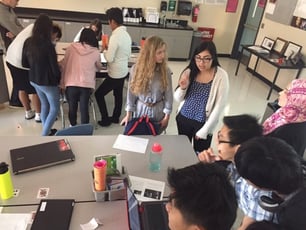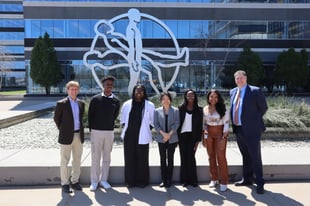Jeffrey Crapper is a biology and health science Career and Technical Education (CTE) teacher at Health & Science High School (HS2) in Beaverton, Oregon. Jeffrey is a National Board Certified Teacher-Early Adolescent Science and earned the honor of 2016 Oregon High School Science Teacher of the Year.
When I first met Oscar, a junior at HS2, he was an extremely disengaged, cynical young man. He was barely on track to graduate, struggling to get Cs in his classes, and rarely participated in classroom lessons or activities. Sadly, Oscar could have easily been one of the 40 percent of Latino males that drop out of high school in Oregon. However, that all changed when he enrolled in my Biomedical Innovation class.
The self-paced, project-based focus of Biomedical Innovation encouraged Oscar to thrive. He took leadership roles in his human physiology experiment in Mission File 2, excelled in his orthopedic injury capstone presentation in Mission File 8, and then coordinated an independent research project involving our biomechanics motion-capture system, which rivals the current motion-capture system used at local universities and graduate schools in the area.
Although Oscar has decided not to pursue a career in the medical field, his appreciation and interest in photography and filming has carried over to an interest in the field of biomechanics. Oscar, on his own, met virtually with biomechanists to develop a screening protocol for female athletes and anterior cruciate ligament (ACL) injuries. His skill and interest has allowed him the opportunity to instruct other students how to use this state-of-the-art activity.
Throughout my career, I have observed the PLTW curriculum transform the lives of my students, especially my students of color and those who are economically disadvantaged. If it were not for the dynamic, highly engaging curriculum embedded into the Biomedical Innovation course, Oscar would have been less inclined to stay focused and engaged academically.
Oscar learned more than valuable academic skills – he exhibited professionalism, leadership traits, and incredible problem-solving skills daily in his various interactions with industry professionals. A year ago, I would have never guessed that the young man who rarely moved his head off the table in class might someday be meeting and collaborating independently with biomechanists and industry vendors from across the country.
And although he has never volunteered before, Oscar completed his volunteer application at HS2 and criminal background check before even graduating, so he can return to my school and volunteer with the motion-capture project. In addition, I’ve seen a level of maturity that I had never observed previously in this young man. In fact, Oscar is an incredible teacher to his former peers and considers the motion-capture project part of his legacy at HS2.
The PLTW Biomedical Innovation course was the mechanism that opened up incredible opportunities for this young man. As Oscar’s teacher, I was blessed to see the development of an incredible desire to learn, which previously had been missing.
Project Lead The Way’s mission of empowering students to thrive might seem to many to be a lofty goal. I can attest, however, that for Oscar, our PLTW Biomedical Science courses delivered on that mission by providing the mechanism for him to finally love the art of learning, take ownership in his own education, and develop the leadership and maturity necessary to converse with industry professionals without feeling intimidated or inferior.
As his Biomedical Innovation teacher, I could not be prouder of him and his amazing accomplishments this year.
PLTW’s blog is intended to serve as a forum for ideas and perspectives from across our network. The opinions expressed are those of each guest author.


